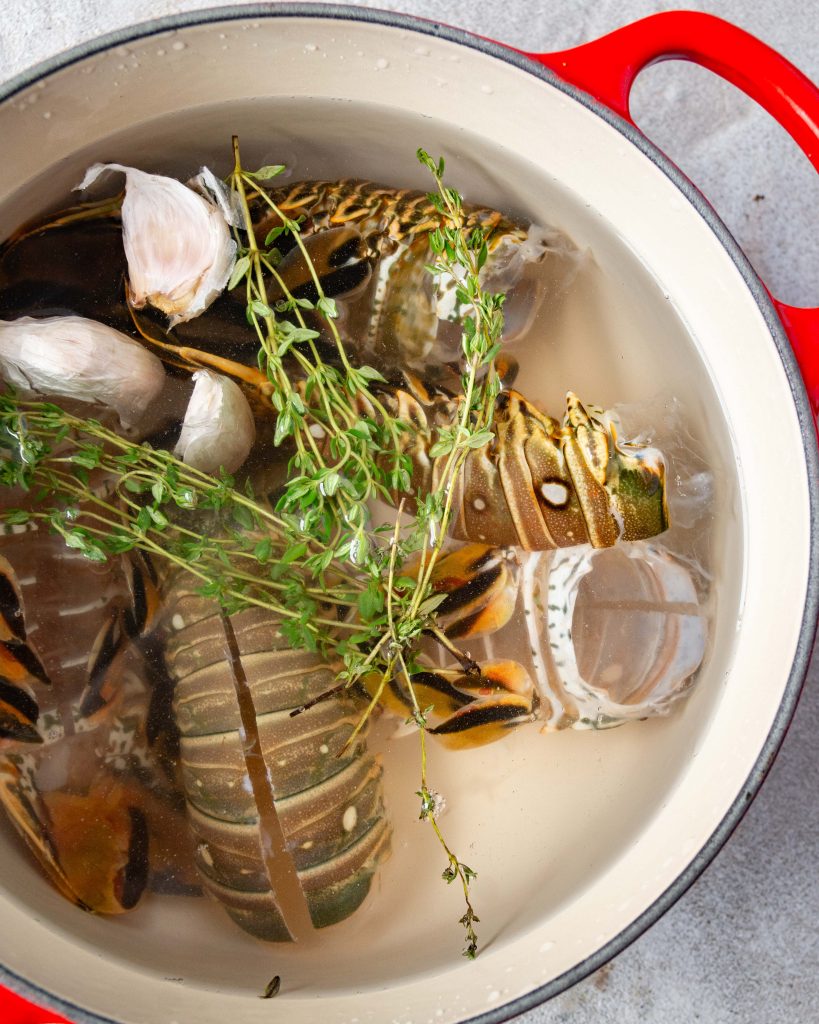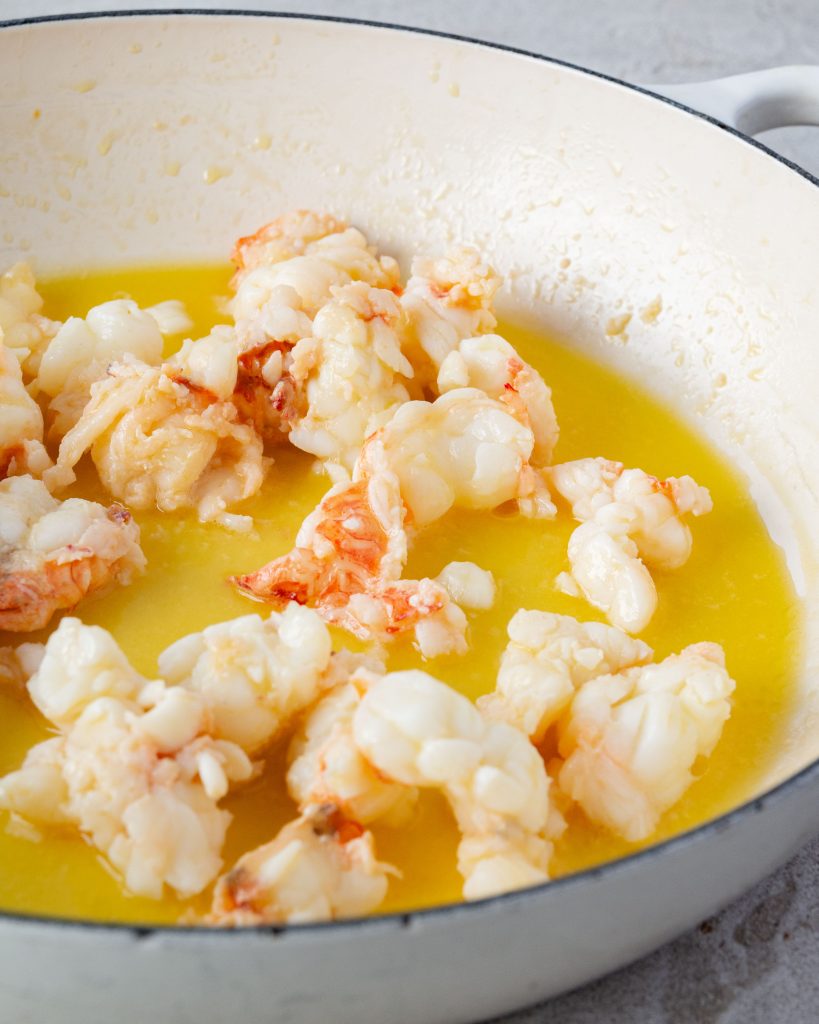Sometimes in cooking you hear about using the whole animal. This is a way of cooking that means that nothing goes to waste. And, when it comes to lobster bisque, nothing at all goes to waste. To create and build that delicious bisque flavour, you’ll use all parts of the lobster from the meat to the shell.

Lobster bisque
Lobster bisque has its origin in French cooking, where bisque originated. However, the lobster part came into play in Louisiana – an area of the US which has a lot of French-influenced cuisine.

What is bisque?
But, “what is bisque?” my Australian friends and readers might be asking. Bisque in Australia isn’t as popular or widely spread on menus as it is overseas. So, to pull back the cloche – bisque is a smooth and creamy soup – highly seasoned and packs a lot of punch. Bisque is all about using the whole animal and all its flavours. In the words of ultimate flavour queen herself, Julia Childs: “Do not wash anything off until the soup is done because you will be using the same utensils repeatedly and you don’t want any marvelous tidbits of flavor losing themselves down the drain.”




Soup is a meal!
It was first in sitcom Seinfeld that the debate of ‘is soup a meal?’ was first had. It was a nemesis of Jerry Seinfeld, Kenny Bania, who claimed “soup is not a meal”. Jerry retorted back, “soup is a meal”. And, we’re here to back Seinfeld on this debate because when it comes to bisque, soup is most definitely a meal!

Let’s build the bisque
So, how exactly do we build the flavours of this bisque? It’s about patience. One to two hours of lobster tails with base flavours to create a delicious seafood stock.
From here, it’s about building the flavours on top of that: white wine to bring acidity, herbs to have a bit of a bite. And then, the soup classics: carrot, onions, bay leaf. All of the soup flavours that make the most sense.

Using all the meat for lobster bisque
I started to make this series because I was craving lobster rolls, and so I created a backyard barbeque classic: buttery lobster rolls. From here I then just wanted to enjoy the lobster whole, so I butterflied and barbequed the lobster with strong garlic flavouring. I then entered into bisque territory.

The secrets to my bisque
Something that I really like doing at the end of my bisque recipe is to garnish it with, you guessed it, chunks of lobster. Because there’s no such thing as too much lobster, that’s like saying your wallet is too full of money! I also like to poach my lobster meat in butter to give it that extra flavour! Cook the lobster meat low and slow when in the butter for that extra tender and juicy meat.

How to serve your bisque
So, serving the dish I use a crack of fresh black pepper, a sprinkling of chives, and some big chunks of lobster meat. Let the eater enjoy it all. You can also add some freshly toasted bread on the bread or even a cheese toastie!

If you make this lobster bisque, please tag me on Instagram, Tik Tok or Pinterest so I can see your wonderful creations!
If you have any questions or would like to leave a review, please do so here! I always love answering your food and recipe related questions and hearing your feedback on my recipes.

Lobster bisque
Ingredients
- 500-800 g lobster tails in shell 1.1 - 1.8 Lb
- 7 garlic cloves peeled
- 4 sprigs thyme
- 5 cups water
- 100 g unsalted butter 1/4 Lb
- 1/2 tbsp olive oil
- 2 celery stalks chopped
- 2 carrots peeled and chopped
- 1 onion diced
- 1 bay leaf
- 1 tbsp tomato paste
- 1/2 cup white wine
- 200 mL heavy cream
- salt + pepper
- chives to serve
Instructions
- Remove the lobster meat from the shell. Using shearing scissors, turn the tail over and cut down the middle. Peel the shell away and remove the meat. Chop into large pieces.
- To create the lobster stock, add the lobster tail shells into a large pot with 3 whole garlic cloves, 2 thyme sprigs and 5 cups of water. On a high heat, bring to the boil then reduce the heat to low – medium or until the stock is at a slow simmer. Pop the lid on and simmer for 1 – 2 hours. Through a fine mesh strainer, strain the stock and set to the side. Discard of the shells and aromatics. You should be left with 4 cups of stock. If you have any extra, store in the freezer and use in any recipe that calls for seafood stock.
- In a heavy based saucepan on a low heat, melt the butter. Drizzle with olive oil and then add the lobster meat. Cook on a very low heat so there is only a slight bubble to the butter as we want to slowly poach the lobster meat. Cook for 3 – 5 minutes or until the lobster meat turns pink. Using a slotted spoon, remove the lobster meat from the pan, ensuring you leave as much of the butter in the pan as possible.
- Turn the heat to medium – high and add the celery, carrots, onion, bay leaf and remaining garlic cloves and thyme sprigs to the pot. Cook for 5 minutes while stirring occasionally. Turn the heat to high and add the tomato paste. Cook for 3 minutes or until the tomato paste turns a deep red brick colour and is almost sticking to the bottom of the pan. Deglaze the pan with white wine and cook until 80% of the liquid has been absorbed. Add 4 cups of the lobster stock to the pot and bring to a simmer. Cook for 30 minutes.
- Using a hand held blender, blend the soup until you have a smooth consistency. You can also do this step in a blender but just be careful and ensure your soup has slightly cooled before blending.
- Stir through the cream. Sprinkle over the lobster meat and chives and finish with a crack of black pepper.





Leave a Reply